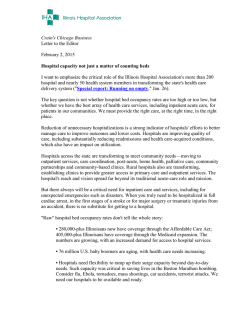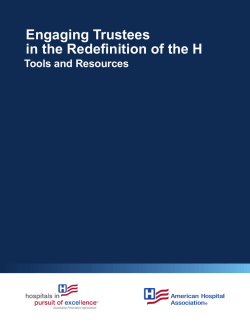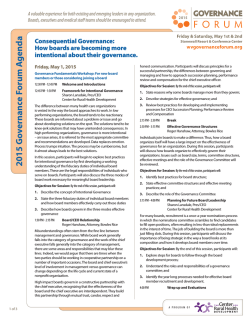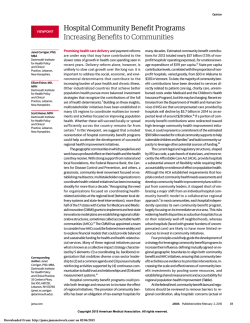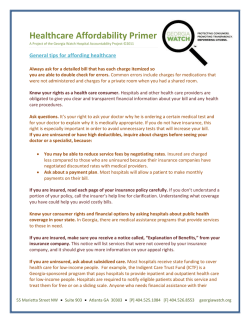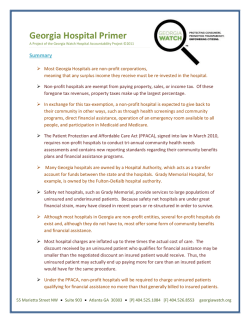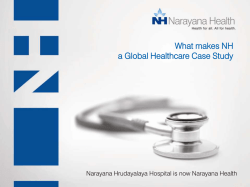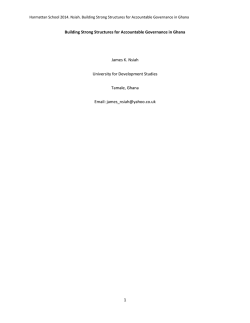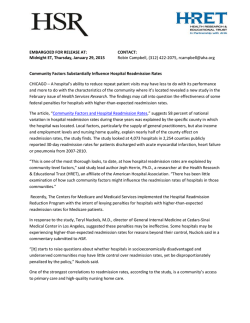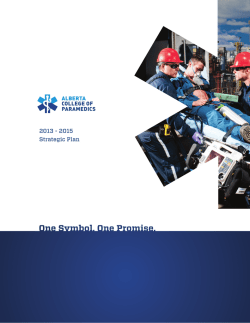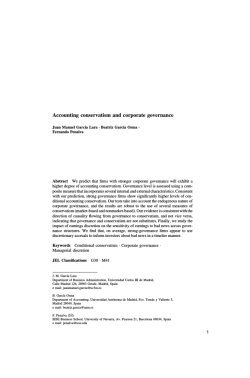
Redefining the H Report w - American Hospital Association
Leadership Toolkit for Redefining the H: Engaging Trustees and Communities Report produced by the AHA Committee on Research and Committee on Performance Improvement – 2015 American Hospital Association Committee on Research 2014 Jonathan B. Perlin, MD, PhD, MSHA, FACP, FACMI Committee Chair Douglas A. Conrad, PhD Lynn Nicholas, FACHE Professor, Department of Health Services University of Washington President and CEO Massachusetts Hospital Association Chief Medical Officer & President, Clinical and Physician Services HCA/Hospital Corporation of America Chief Executive Officer Providence Sacred Heart Medical Center Elaine Couture, BSN, MBA, RN T.R. Reid Jessica Anderson Diane S. Cross Chief Medical Officer Mayo Clinic Hospitals/Mayo Foundation Kenneth W. Freeman Board Chair Allegiance Health Board Chair Rutland (VT) Regional Medical Center Senior VP Wealth Management UBS Financial Services Rhonda Anderson, RN, DNSc (h), FAAN, FACHE Chief Executive Officer Cardon Children’s Medical Center Art Blank President and CEO Mount Desert Island Hospital Mary Blunt Corporate Vice President Sentara Healthcare Laura Caramanica, RN, PhD, CENP, FACHE Chief Nursing Officer WellStar Kennestone Hospital Lawrence P. Casalino, MD, PhD Chief of the Division of Outcomes and Effectiveness Research; The Livingston Farrand Professor of Public Health Department of Public Health Weill Cornell Medical College Michael Chernew, PhD Trustee University of Minnesota Health Former Trustee, HCA Allen Questrom Professor and Dean Boston University School of Management Daniel L. Gross, RN, DNSc Executive Vice President Sharp Healthcare Author Michael G. Rock, MD Lawrence H. Schultz John J. Singerling, III, FACHE President Palmetto Health Joseph R. Swedish Edward L. Hatcher President and CEO WellPoint, Inc. Raymond T. Hino, MPA, FACHE President and CEO AtlantiCare Mary Kitchell President and CEO American Hospital Association Douglas Leonard Managing Director Citigroup Global Markets Inc. Immediate Past Chair Grinnell Regional Medical Center Chief Executive Officer Bear Valley Community Hospital Trustee Mary Greeley Medical Center President and CEO Indiana Hospital Association Steve Love President Dallas-Fort Worth Hospital Council Professor Department of Health Care Policy Harvard Medical School 2 David P. Tilton Richard J. Umbdenstock Lorrie Warner Joe Wilkins, FACHE Board Chair St Joseph Hoag Health Maryjane Wurth President and CEO Illinois Hospital Association American Hospital Association Committee on Performance Improvement 2014 Thomas W. Burke, MD Committee Chair Executive Vice President, Cancer Network The University of Texas M.D. Anderson Cancer Center Bruce Bailey President and CEO Georgetown Hospital System Barclay E. Berdan Chief Executive Officer Texas Health Resources Damond Boatwright Regional President/CEO Hospital Operations SSM Health Care of Wisconsin Carolyn Caldwell Chief Executive Officer Desert Regional Medical Center Andrew Carter President and CEO The Hospital and Healthsystem Association of Pennsylvania Joy Drass, MD President and Chief Executive Officer White County Medical Center Christopher J. Durovich President and CEO Children’s Medical Center of Dallas Executive Vice President and Chief Operating Officer Virginia Mason Medical Center Georgia Fojtasek Julie Quirin, FACHE President and CEO Allegiance Health A.J. Harper Chief Executive Officer Saint Luke’s Hospital of Kansas City Michael G. Rock, MD Chief Medical Officer Mayo Clinic Hospitals/Mayo Foundation Mary Henrikson, MN, BSN, CENP Mary C. Tonges, PhD, RN, NEA-BC, FAAN Vice President for Patient Care Services, CNO/COO St. Anthony Summit Medical Center Mary Anne Hilliard, Esq, BSN, CPHRM Chief Risk Counsel Children’s National Medical Center Donna Katen-Bahensky Former President and CEO UW Hospital and Clinics James Diegel President Iowa Hospital Association President and CEO St. Charles Health System Sarah Patterson President Hospital Council of Western Pennsylvania Vickie Diamond, RN, MS President and CEO Wyoming Medical Center Raymond W. Montgomery II Executive Vice President, Operations Washington Region MedStar Health Chief Nursing Officer and Senior Vice President UNC Hospitals Richard J. Umbdenstock President and CEO American Hospital Association Raymond P. Vara, Jr. President and CEO Hawai‘i Pacific Health Kirk Norris © 2015 American Hospital Association©. All rights reserved. All materials contained in this publication are available to anyone for download on www.hpoe.org for personal, noncommercial use only. No part of this publication may be reproduced and distributed in any form without permission of the publisher, or in the case of third party materials, the owner of that content, except in the case of brief quotations followed by the above suggested citation. To request permission to reproduce any of these materials, please email [email protected]. 3 Table of Contents Executive Summary 5 Introduction10 Engaging Communities in the Redefinition of the H 15 Engaging Trustees in the Redefinition of the H 20 Putting it All Together 26 4 Executive Summary The blue and white hospital “H” carries the promise of help, hope and healing. While the hospital of the future will continue to extend that promise, it may do so in significantly new ways. Hospitals do more than treat injury and illness; many serve as cornerstones within their communities, both in terms of advancing health and well-being, as well as being an economic engine. Hospitals’ accountability and commitment to their communities are not only for the care provided within the hospital walls, but also for improving the overall health of the communities served. Many are acting on that commitment by striving to achieve the goals set out by the Institute for Healthcare Improvement’s Triple Aim: improving the patient experience of care, improving the overall health of a population and providing high-quality care at an affordable cost. As communities contemplate health and health care, hospitals of the future must become true community partners and work collaboratively with diverse stakeholders to help individuals reach their highest potential for health. (While the report refers to hospitals, the concepts are meant for both hospitals and health systems.) While issues of access, cost and quality were drivers for the Affordable Care Act, response to these changes are now being formed through both payment and delivery system reform. Hospitals are using the Triple Aim to guide them as they look at different paths and approaches to redefine themselves and further develop strategies and business models for sustainability. They are improving the overall health of our country, our community and our patients through: n Improving the experience of care for patients, involving patients and families in care teams, helping to coordinate services among providers and helping patients navigate the health system; n Moving toward proactive, population health with a strong focus on prevention and wellness strategies, keeping patients safer and out of the hospital; and n Working to reduce non value-added care and identifying opportunities to increase efficiency, improve quality and reduce the overall cost of care. As shortcomings in health care performance and health outcomes are contemplated in the context of unsustainable costs, the changes occurring now are prompting hospital leaders, boards and others to consider what changes are needed to ensure that care continues to be provided for our families, friends and communities. Our patients, policymakers, legislators and businesses are also demanding change! Given the financial pressures our nation faces, there is significant economic stress on the entire health care sector, and resources allotted for health care will be under even greater scrutiny in coming years. Increased efficiency and quality are paramount. At the same time that we find ourselves with diminishing resources, our health care system will also be caring for an increasingly large aging population – baby boomers who are living longer – and many patients experiencing multiple chronic conditions. Despite these 5 challenges, technological and medical advances are allowing caregivers to deliver care that is more complex and more individualized than ever before. This progress will impact how care is delivered and financed and will necessitate the need for hospitals to focus locally on finding the best community solutions to improve health outcomes. Hospitals today are intently focused on redefining the “H,” exploring what it means to be a hospital in a rapidly transforming health care world. Among other things, the move from a fee-for-service to a value-based environment is prompting hospitals to intently focus on quality, embrace population health management (both defined as “attributed” and geographic populations) and promote more integrated, better coordinated care with goals to improve the health of the community through increased access to primary care, appropriate admissions and reduced inappropriate readmissions, along with making measurable gains in improving outcomes of care and reducing harm. But these achievements cannot be accomplished in isolation because the rising costs of health and health care are unsustainable. Given these fiscal pressures, hospitals must carefully consider the allocation of resources for the health and health care of the communities they serve. The concept of population health may begin as a core responsibility for hospitals and health systems to keep their “attributable population” of patients well and out of the hospital, provide care in a coordinated manner and integrate with all relevant care providers. As transformation evolves and with strengthened community collaborations, hospitals may begin to move toward looking at population health in terms of broad health needs within their community and the determinants of health that inhibit wellness and improved health status of a geographic population. These challenges will require that hospital boards lead the way in forging community collaborations that: n Appropriately allocate resources and define a shared responsibility for improving community health; n Bring insight, perspective and support from the community into the hospital board room as hospital leaders consider paths for transformation; and n Enter into strategic partnerships for improving community health and health outcomes. Strengthen Community Partnerships Maintaining a strong linkage with the community through a diverse group of community stakeholders will be more important than ever, and the ability to do so will become a key competency for boards and an important strategy for hospital leaders as they look to better understand their community’s needs. Collaboration through community health needs assessments and other strategic endeavors will be vital as a foundation for planning and methods to align health priorities and goals to achieve the best outcomes for health. Executive teams should be community oriented themselves and also look to identify community leaders to fill new roles within the governance structure of the hospital or health system. Inviting community members to serve on committees or attend key board meetings to share their knowledge and understanding of the patients and community can be extremely valuable. Governance Will Be Key The American Hospital Association (AHA) has recognized that redefining the “H” also includes a component of redefining the “G,” or determining the changes necessary to ensure that the governance structure is fully capable of ensuring purposeful, productive hospital leadership well into the future. Now is the time to concurrently redefine the role 6 and expectations of hospital boards in both providing leadership excellence while also engaging multidisciplinary teams within the hospital. Teams should include physicians, nurses, volunteers, patient advocates and others, while also connecting with diverse community stakeholders for their insight into community health challenges and priorities. Boards will be responsible for fostering collaboration, supporting changes that will likely occur during these dynamic, transformative times and translating such change into positive action and outcomes for the community. High levels of complexity and uncertainty that underlie the transformation taking place in health care organizations across the United States require careful risk-taking by leadership teams that must take these risks in partnership with their boards, medical staffs and communities. Boards that clearly understand the environment, the uncertainty and the need to take carefully calculated risks will be most understanding and supportive of the leaders responsible for managing these risks and leading the organization into the future. The AHA recently embarked on an effort to better understand where hospitals and communities were in their journeys of transformation and used that feedback to influence the work of both the Committee on Research (COR) and the Committee on Performance Improvement (CPI). The AHA received approximately 1,100 responses from board chairs, CEOs, CFOs, CNOs and others about redefining the “H.” The general consensus was that, nationally, there would be fewer independent hospitals, with more hospitals joining health systems. Additional predictions for the future included more hospital/physician affiliations, more value-based payments, a shift to payments that are fixed or capitated and more providers owning health plans. Locally, hospitals felt they would see decreasing or flat inpatient revenue; increasing outpatient revenue; increases in the amount of primary, preventive care; greater integration of technology; and growth in the use of interdisciplinary teams to achieve more coordinated care. With delivery and payment reform, it is becoming clear that hospitals must adapt to survive. The AHA has identified five possible paths for transformation that are not mutually exclusive: n Specializing to become a high-performing specialty provider, such as a children’s hospital or rehabilitation center; n Partnering though a strategic alliance, merger or acquisition for greater horizontal or vertical reach, efficiency and access to resources; n Redefining to a different delivery system that is either oriented toward more ambulatory or more toward long-term care; n Experimenting with new payment and delivery models, such as bundled payment, accountable care organizations (ACOs), clinically integrated networks or medical homes; or n Integrating by developing a health insurance function or services across the continuum in areas such as behavioral health, home health, post-acute, long-term care, ambulatory, etc. 7 The AHA believes that changes as significant as those likely to occur in the coming decade need to be planned for, not only within the hospital but also with strong input and engagement from the local community. As hospitals consider redefining themselves, it is crucial that they educate and engage leaders at the governance level who can then help navigate new payment models, delivery system reforms and new community health challenges. As hospital board members guide hospitals during this time of change, they will bring important perspective from their community roles and be able to provide insight as to how different paths of transformation may affect the community. For hospitals to maintain this strong linkage with their community and to be most impactful in addressing community health needs, they will need to work much more collaboratively with a wide range of community entities to identify the most critical health needs and challenges faced by the community. They must also consider the obstacles that exist to achieve good health, unite around shared goals and work collaboratively to implement changes that promote a healthier community and do so while developing a sustainable business model. Additionally, boards and hospital leaders must maintain a strong local presence and reflect the individual communities they serve. Changes will not be effective if done only with national or regional input. These basic premises prompted the AHA COR to invest the past year looking into trustee engagement as it relates to redefining the “H,” and the AHA CPI to focus on how hospitals can engage with community stakeholders to have conversations about the changing health care landscape. Drawing from this work, this report includes an overview of community engagement and governance strategies for hospital leaders and can serve as a leadership checklist for engaging both communities and trustees. 8 LEADERSHIP TOOLKIT Common Themes and Recommendations When Engaging Communities: n Collaborate through building trust and engagement among all stakeholders n Start locally when considering transformation n Envision n Engage n Drive in broad-based dialogue policy changes that support collaboration n Provide n Use a future when care looks different than today frequent and ongoing communication community health needs assessments as a critical planning tool n Consider a holistic approach to health care Current High-Performance Governance Practices: n Define a clear mission and vision for a transformed enterprise n Create an environment of trust n Establish n Build a foundation of effective communication a board-CEO co-leadership partnership New Bold Steps to Equip Boards for Transformation Work: n Develop n Ensure the right governance dialogue n Commit n Have trustees for the future to continuous trustee education and knowledge building courage to make the difficult decisions 9 Introduction Health care payment reform and delivery system transformation have set in motion myriad changes in how health care is financed, how providers are compensated and how care is delivered. As the hospital field works to redefine the “H” and achieve the Triple Aim on behalf of our patients and communities, we must actively engage trustees and our communities now in the changes that will inevitably come. To successfully navigate the transforming health care system, all community stakeholders must have candid, strategic conversations about the direction of local health care. It is imperative that hospital leaders, governing boards and community stakeholders join together to identify paths for change that will improve the health of the community. To effectively strengthen the health care system, both locally and nationally, hospital boards must: n Become knowledgeable of hospital’s changing business model, understanding new delivery system reforms and changes to the reimbursement system; n Ensure that boards are both representative of the community but also representative of the skills and competencies needed to best lead a hospital or health system through transformation; n Willingly and regularly engage with community stakeholders to educate them about the challenges being faced by hospitals, learn from them about community needs and challenges and work jointly to create an infrastructure for change that aligns community health goals; n Consider a local board structure that allows the individual hospitals to maintain a strong local presence, best understand community challenges and regularly welcome community members and patients into the board room; and n Address possible business models to achieve and sustain goals. Hospitals must join with other diverse community stakeholder groups to: n Assess both community health challenges and strengths; n Identify gaps in competencies and services (what services are lacking within a community, in which areas does duplication exist, what trained health care providers are needed, etc.); n Proactively collaborate and strengthen diverse partnerships to facilitate greater community collaboration; n Break down community silos to create a shared vision for future health care, including but not limited to the role of the hospital, within a community; and n Develop sustainable business models that allow partners to first achieve but then sustain goals. Collaboration is essential as hospitals and communities move toward better coordinated, more integrated care and adopt a population health model of keeping people healthy and reducing preventable hospitalizations. Many hospitals are moving toward a more coordinated population health model for their attributable body of patients, but as hospitals and health systems partner more closely with community stakeholders, they will likely also begin looking more broadly at a geographic population health approach based on the health needs of the community and region they serve. Strong guidance and leadership 10 within hospitals will be key during the shift from a volume-based system to a value-based system, as will the ability of community stakeholders to come together, unify and support change regardless of diminishing or sometimes competing resources, financial and otherwise. Hospitals and health system leaders must think broadly as they plan for transformation, but all new system design will require the delivery of increased value. First and foremost, leaders must look for opportunities to improve the quality of care provided, identify strategies to provide more efficient, high-quality care and work with communities to go “upstream” to address the determinants of health. Any change that may occur to the “brick and mortar” hospital must be viewed in the full context of health services provided in a community, as the greatest impact on health outcomes are determinants of health that reach beyond clinical care. The Robert Wood Johnson Foundation’s America’s County Health Rankings identifies the following factors that can impact an individual’s health and, ultimately, health outcomes for a population: n Health behaviors (tobacco use, diet and exercise, drugs and alcohol) n Clinical care (quality and access) n Social and economic factors (education, employment, income, transportation, etc.) environment (air and water quality, housing and transit) n Physical With the goal of educating communities on transformation, the AHA CPI hosted several community events across the country, listening and learning from community partners and seeking to foster further community collaboration and engagement. Woven through many conversations was the concept that determinants of health can no longer be overlooked as the health system moves toward a population health model of keeping individuals healthy and reducing preventable hospital stays. If this is in fact what the future health system has in store, hospitals, hospital leaders and all other health care entities must think of health much more broadly than a single encounter within a hospital and must plan and work strategically for an integrated, coordinated approach to keep our communities healthy. Hospitals and other partners in health within a community must align goals, resources and expertise around a sustainable model for improvement. Drawing upon community leaders whose backgrounds are focused on the social services available within a community, as well those who possess knowledge of the specific challenges or social determinants present within a community, and inviting these individuals to join the governance conversation by serving on advisory groups, board committees or the governing board are examples of nontraditional input. But moving forward, such individuals will become essential. The COR conducted a separate survey on the readiness of trustees to adapt their governance practices to these new realities. Survey responses were collected from 949 CEOs and 629 trustees (Table 1). While there was agreement that trustees were knowledgeable about the coming transformational changes, there was significant disagreement about their engagement in new governance practices and a significant difference in their perspectives on how far their organizations have progressed in transformation. 11 Table 1 Health Care Transformation: Comparison of Trustee and CEO Responses Question Wording (1 to 5 scale) Trustee Mean N=629 CEO Mean N=949 3.88 3.86 • Examining emerging governance models and considering how they might apply for our organization 3.52* 2.98 • Having candid strategic discussion about what health care transformation means to our organization/how to best deploy assets to meet community health needs 3.96* 3.82 • Developing a new vision and strategy for transformational change in our organization 3.85* 3.69 • Developing future-focused metrics that assess today’s performance and shape future outcomes 3.56* 3.32 • Strengthening board and organizational competencies to manage change and risk 3.56* 3.25 • Developing new or revised competencies required for board membership in a transformed environment 3.05* 2.80 2.98* 2.79 1. How knowledgeable is your board about the transformational changes occurring in health care? 2. To what extent is your board currently engaged in the following practices to prepare for governing in a transformed health care delivery environment: 3. How far is your organization on the journey to create a transformed health care organization? *=p<.05 Source: AHA CPI/COR, 2014. The CEOs and trustees were also asked more open-ended questions about their board’s engagement in the work of transformation (Table 2). Here the differences were more in tone and understanding. The board members perceived themselves to be more engaged, wanting more education and resources, while the CEOs’ perceptions of trustee performance were that they were disengaged and lacked education. This difference in perception creates a serious challenge for organizational success and must be aggressively addressed by CEOs and their board members before the “H” can successfully be redefined. 12 Table 2 Change Trustee Perspective CEO Perspective Board education/ development • Understandable, “simplified” education about the national and local changes occurring in health care • More opportunities for education • Ongoing focus on education about care delivery and financing changes • Education on what good governance is all about Board composition/ skills/competencies • New board members with transformational skills • Competency-based board recruitment and evaluation • More clinicians on the board • More diversity (gender/age/racial/ ethnic) • Need a more “professional” board • Skill level of current board is inadequate • More knowledgeable board members (“you can only educate so much”) Strategic focus • Agendas need to focus more on strategy for the future • Board members lack strategic perspectives/focus • Community hospital board in a system does not have strategic relevance Board engagement/ time commitment • Make board education mandatory so all trustees have to commit the time to it • More frequent board meetings • Can’t get board members to engage on the tough issues • Board members won’t commit the time needed for strategic discussions – they are too busy • Greater board member accountability Streamlined governance structures • Clarify relationships/authority between boards of new entities (affiliations/mergers) • More board committees • Smaller, more nimble board • Simplify the governance structures Best practices/ data/metrics • Future-focused performance metrics • Need to know how others are approaching change – what works and what doesn’t • Better IT systems to give us relevant data • Future-focused performance metrics • Better IT systems to give us relevant data Physician leadership/ alignment • Make sure our physicians are aligned with our future • Better integration of board, CEO and physicians into decision making • More engagement from the physicians on the board • Clinical collaboration on need to move to evidence-based practice Better board-CEO relationship • More open dialogue between board and CEO • A true partnership between the board and CEO • Better senior leadership commitment to the board N/A Change government/ ownership constraints • Open meetings make strategic discussion impossible • Publicly elected board is unprepared to govern Community perspective/ involvement • We need community focus groups so they have input into the future direction of the hospital • Staying focused on our mission on behalf of the community • Community understanding/ engagement on health care changes Source: AHA CPI/COR, 2014. 13 Need for Change Today’s health care environment is highly volatile. Uncertainty places increasing risk on CEOs and the decisions they make. Yet maintaining the status quo is not an option moving forward. CEOs are responsible for steering their organization in the right direction for future success in achieving the hospital’s mission and vision. Bold and necessary moves may be unpopular with employees, nurses, physicians and even the community, but they may also be necessary to transform the organization to ensure its success in a health care world that will be dramatically different from today’s. New and Diverse Partnerships As CEOs make tough and controversial decisions and set bold new directions, it is important that they have full confidence in their board’s involvement in, support for and enthusiastic endorsement of their actions. Educated and engaged boards that possess relevant competencies can be a key resource for a hospital or health system CEO and serve as an ambassador for change. Establishing diverse partners and community collaborators can help guide the decisions of CEOs and help them better understand the health challenges and concerns of their community. Additionally, CEOs can use the involvement and support from community partners as a strategic opportunity to reduce concerns or alleviate opposition to changes brought about during transformation. Board Support CEOs will also need to be supported by their board when they encounter problems in taking risks and trying new ideas. When the board has a full understanding of the issues and challenges facing the organization and when the board is able to bring a core competency grounded in community connectivity, both will operate in a trusting and successful partnership. That partnership requires trustees and the CEO to work together seamlessly, united to achieve the highest level of organizational success. The relationship can be enhanced through a clear understanding of one another’s needs, responsibilities and expectations, clear and consistent communication, mutual goals and objectives, dialogue-rich and purposeful meetings and a constant sharing of timely and critical information. This partnership is the foundation of great governance practices. Board Preparation and Competencies Redefining the “H” will require hospitals to equip boards with new skills and tools and empower them to make hard decisions in the face of uncertainty. Boards must: n Stay connected and be able to translate the health needs of their communities; n Assess possible partnership opportunities for better integrated, more coordinated care across all care settings; as a liaison between the hospital and the community and lead the hospital to be a convener of community stakeholders; and n Lead the organization to take necessary steps and adapt appropriately in light of the realities of the changing health care environment. n Serve Mission Alignment Hospitals must reconsider, how they alone, or through diverse partnerships with aligned goals and resources can best fulfill their mission of improving health for patients and communities. To better equip hospitals for success during transformation, leaders must recognize the importance of collaborating, educating community stakeholders on the changes 14 ahead and engaging and partnering with those organizations which can best help care for the overall health of patients and the community as the health care system shifts to a population health model. Additionally, boards must also recognize the need for new competencies, educational opportunities and collaborative approaches to best govern their increasingly complex organizations with multiple clinical and operational units and functions, as well as expanded continuum of care settings. Governance roles and responsibilities at each level of the organization will vary but should be coordinated into an integrated and efficient governance system. Boards should never forget their unique opportunity to foster further community collaboration that can bring different, but essential, community perspective to the boardroom, to successfully steer their organization through the changes ahead. Engaging Communities in the Redefinition of the H Hospitals leaders and boards must not be insulated in thinking about the challenges and opportunities associated with this transition, but should consider new ways to engage with communities and think about what changes to the health care system will mean for patients and consumers. It would be unfortunate for a hospital to be redefined in a manner that does not positively impact the overall health of a community and, therefore, is not supported by the community. Community Conversation events should include discussions on transforming community health, not just the hospital, and should examine the role stakeholders will play in that process. To assist hospitals in developing community engagement strategies that can influence the process of transformation and build an infrastructure for better health, the AHA CPI oversaw the development and implementation of several “Community Conversations” events. The conversations were held in six states across the country and brought together a diverse group of community and health care stakeholders for a moderated discussion around current health challenges, implications of transformation and a shared future and vision for the hospital’s role in community health. (Overviews from the individual events can be found in the Tools and Resources section, Tool 2.) All health care is local, and transformation is likely to play out differently in different communities. That is why, regardless of the work the AHA is doing to gain some national perspective, it is very important for hospitals to convene community stakeholders and to listen, learn and gain an understanding of the impact such changes may have on the community. Doing so will put hospitals and communities in the best position possible as the role of the hospital changes and population health emerges as a framework for achieving the Triple Aim. All community health partners, including multiple or “competing” hospitals, must find ways to collaborate and work together, breaking down barriers for change and sharing goals for improved health status. Specifically, the CPI was interested in prompting community engagement and underscoring the role that community stakeholders can play in influencing how hospitals redefine themselves as health care moves from a volume-based to a value-based business model. As such, the primary objectives of the Community Conversation events were to: n Engage in a robust discussion on emerging health care trends; n Gain a shared understanding of changing community health needs; 15 n Consider how changes and trends might impact hospitals and, more broadly, the health of a community; and n Encourage further dialogue and collaboration among all stakeholders on the changing role of hospitals in community health. The events proved to be an effective strategy for listening, communicating and collaborating with stakeholders. Thinking about transformation from the patient, consumer or community stakeholder perspective was enlightening. There was uniform agreement among participants that the health care system is approaching a time of rapid change that will impact the current infrastructure of community health. Cost and coordination of care were generally identified as two of the biggest obstacles in health care transformation. Enhanced behavioral health and preventive services, along with more coordination with social services, were identified as the top areas most in need of improvement. While every community has its own unique characteristics and populations to consider, the concept of collaboration being crucial to transformation emerged during each conversation as a common recommendation as hospital leaders and boards look to solve the bigger challenges around changing the health care environment. Common Themes 1. Collaboration Is Key: Collaboration and partnership mean that no one hospital or health system has to be all things to all patients. There was a general recognition among the event attendees that the hospital may no longer be the only, or even most appropriate, entity to provide certain services. When the patient’s best interest is the primary focus, silos of care that exist within a hospital or health system, as well as with other community stakeholders, will begin to break down, allowing for better coordination and health outcomes. 2. Transformation Will Be Local: While policy changes are needed and will certainly impact how health care evolves, change must start locally. “Local will” that ensures needed health care services are available within a community was believed to be stronger than “political will” and likely to facilitate change faster than waiting for policy changes. While hospitals and health care stakeholders will continue to push for favorable policy changes, hospitals must be careful that transformation is done as a community, not to a community. 3. Care Might Look Different: As the health care system transforms and as local hospitals and communities take a closer look at existing services and areas of need, communities may see changes in the number of inpatient hospital beds, where care is provided, the type of services a hospital offers and which providers and stakeholders become part of the extended care team. Challenges and Lessons 1. Align Community Priorities and Funding: Funding and collaboration between health care, public health, social service organizations and other community partners were discussed as needing aligned priorities and incentives that are more closely coordinated. Narrowing in on a shared goal and aligning financial incentives with all stakeholders will accelerate transformation at the community level. 16 2. Behavioral Health Services Are Inadequate: The need for augmented and better integrated mental and behavioral health services was a strong theme throughout all of the events. The current fee-for-service system does not support optimal provision of these services. 3. Primary Care Physicians Are In Shortage: Another universal burden discussed in each conversation is that the Affordable Care Act is creating increased and immediate demand for primary care providers while there is a shortage of primary care physicians coming through the educational system. Access to adequate primary care will be essential as the health system moves to a population health model. Nurse practitioners and other advanced practice professionals should be considered to fill the gap. 4. Social Determinants of Health/Socioeconomic Status Must Be Considered: Looking at the overall health of a patient or of a community, beyond an episode of hospital care, will prompt hospitals and other health care and social service providers to identify and account for determinants of health. Without addressing these factors, overall health may not be achieved. Some of the challenges discussed include: n Transportation for underserved populations n High costs of prescription drugs preventing some patients from taking needed medications that could improve health and prevent readmission to the hospital n Food deserts and limited access to healthy meals n Weak educational opportunities 5. Stakeholders Need the Ability to Better Share Information and Data: Lack of communication and the inability to both share and access health information and data were identified as being significant barriers to success in some communities. Having the ability to share data, and then determining how best to communicate information between providers, would improve handoffs of care and ultimately create more integrated communities and healthier populations. 6. Different Types of Providers Will Face Unique Challenges: While collaboration and care coordination are being discussed, the smallest hospitals must not be overlooked. There was a shared concern among Community Conversation attendees for how rural hospitals will be able to successfully transform without many of the resources and potential partners available in more urban areas. Urban and safety-net providers also face challenges, as they care for large, underserved, ethnically diverse populations. Additionally, community collaborations and partnerships may be more difficult to initiate in markets with significant competition and multiple providers. Recommendations 1. Engage in Broad-Based Dialogue: Be committed to understanding community health challenges and move outside the hospital’s comfort zone to listen to voices and perspectives that often go unheard in general hospital meetings and planning sessions. Doing so can open the door to hearing about all the things your community thinks the hospital can and should be doing for the community. Community Conversation events present an opportunity for education and, most importantly, for listening and learning and then most likely strengthening vital community relationships. (See a full listing of potential stakeholders in the Tools and Resources section – Tool 1.) 17 2. Policy Changes Must Support Collaboration: As health care policies change both nationally and locally, hospitals along with other community partners should join together to ensure that policy changes incentivize public and private partnerships that would help consumers become more integrated into the health care system and more active in their health care. 3. Frequent and Ongoing Communication Is Needed: Bring stakeholders together around vested interests and look for existing forums to do so. Ongoing forums and continued community conversations will be critical for understanding the changing health care environment. Hospitals can play an important role as a convener of such dialogue but should not necessarily lead the conversations. Communication and education, when appropriate, must occur often among all community stakeholders – among different hospitals, health care stakeholders and, most importantly, non-health care community partners. Engaging with consumers and other community leaders will offer important insights during transformation. 4. Community Health Needs Assessments (CHNA) as a Tool: The needs assessment can be an important tool in facilitating transformation, collaboration and allocation of community resources. The assessment should be considered a foundational element of partnership and serve as the center for ongoing dialogue about health needs of the community. Data must be objective and allow all stakeholders to join around priority health goals. This is an infrastructure and process already in place and should be used more strategically. With collaboration increasing in importance, it is no longer enough for hospitals and health systems to conduct community health needs assessments only because they are required. Rather, the CHNA should be an interactive, collective process that helps multiple stakeholders lay a foundation and infrastructure to “do more” together. 5. A Holistic Approach to Health Care Is Needed: What will the “H” represent in 10 years? Much more than “Hospital.” People should see it and think of “Health.” As delivery and reimbursement systems change to incentivize keeping patients healthy and out of the hospital, the hospital field must be looking at a holistic approach to care, prevention needs to be front and center, and more than just hospitals and the health care system will be needed to impact change. Our focus should be on determinants of health, not just health care or hospital care. (Please find case examples in the Tools and Resources section, Tool 3, that illustrate examples of hospitals that are engaged in successful transformation.) Hosting a Community Conversation The approach and process used by the CPI to host six Community Conversation events can be used as a model for other organizations looking to engage with their communities. A complete “how-to” toolkit is provided in the Tools and Resources section, but below is a brief outline should you want to host a Community Conversation in your area. If the format or structure outlined below for Community Conversation events does not work for a particular hospital or community, the concepts of engaging with diverse community partners, aligning shared goals and working to collaboratively improve community health should be incorporated into a strategy that best fits the dynamic of the particular organization. 18 n Early Planning – Date and venue selection, agenda development and event planning and logistics can be done well in advance and will allow for a more strategic selection of attendees and targeted outreach as needed. n Convening a Diverse Group – Participant selection will be key to the success of your event and the involvement of non-health care stakeholders will be extremely beneficial. The Community Conversation events are intended to be structured dialogues with invited community stakeholders, not open to the public. We encourage you to think beyond your comfort zone to convene a group of diverse stakeholders who can bring the full spectrum of community perspectives to the conversation, whether that be the local YMCA, food bank, university or banking institution. Including hospital trustees in these conversations can be helpful, as they often serve as a bridge between the community and the hospital or health system. Building trust among diverse stakeholders will be key, and this is an area where hospital trustees can be helpful. n Event Logistics – While locations may vary greatly, key considerations should include selecting a venue that is easily accessible for all participants and that allows for a setup that prompts optimal discussion, such as a hollow U. n Speakers Selection – The six Community Conversation events held by the AHA and state hospital association partners were led by a moderator who was selected to serve as a knowledgeable, yet third-party entity who could keep the conversations moving in a productive manner. Any speakers who are invited to participate, whether they may be offering an overview of the national health care landscape or a snapshot of the local hospital and community environment should be prepped in advance with relevant materials, agenda and audience overview. n Pre-Event Survey and Materials – While the intent is for the Community Conversation events to not be overly hospital centric, consider sharing a basic framework for the discussion and the brief survey. The responses can provide helpful insights prior to the event, gauging basic understanding, perceptions and expectations of the attendees. Based on the perceived knowledge that participants have of the hospital and the breadth of services it provides, it may be appropriate to include a brief overview or synopsis of the mission and level of engagement the hospital has with the community. It is equally important that neither the background materials nor survey should be cumbersome for attendees. n Small Group Breakout Discussions – Breakout group discussions were found to be an extremely insightful portion of the Community Conversation events. While moderators in all locations tried to elicit a robust conversation among attendees, the small group settings allowed participants to delve deeper into certain areas and share ideas and concerns specific to the community and their unique perspective as a community stakeholder. n After the Community Conversation – Post-event follow-up provides the convener with an opportunity to thank participants for attending, share basic themes and take-aways from the discussion, and solicit a post-event evaluation as well as identify any possible next steps in the collaboration of community stakeholders. 19 “The part that is exciting for boards is that they really are the ‘translation’ – the place where what a community wants (or thinks it wants) gets translated into action by management of a health system. To be able to be close to – but not at – the bedside in terms of what a provider is able to do for an individual patient and a community as a whole is the reason why people serve on boards – they make a difference!” Carolyn Scanlan Trustee, Lancaster General Health (Lancaster, Pa.) Engaging Trustees in the Redefinition of the H Health care reform and delivery system transformation have set in motion myriad changes that will test even the most experienced boards and CEOs. Redefining the “H” requires new structures to effectively govern increasingly complex organizations with their multiple clinical and operational units and functions. Governance roles and responsibilities at each level of the organization will vary but should be coordinated into an integrated and efficient governance system. In addition to restructuring governance, health care organizations will need to better equip trustees with new skills and tools as well as empower them to make hard decisions in the face of uncertainty. Boards must be able to translate the health needs of their communities into appropriate action by their organization, in the light of the realities of the health care environment. This will include reconsidering how they alone or in partnership best serve their mission, including whether or not it is only their organization that can meet that mission. Defining the Role of Boards at Different Levels of the Organization Health reform challenges, the prospect of lower reimbursement, the lingering effects of a recessionary economy and the need for capitol are driving increased alignment among hospitals, physicians and other providers seeking to find economies of scale, streamline processes and improve their appeal to consumers. To be poised and ready to take advantage of new opportunities, hospitals must have a governance and management structure that facilitates organizationwide strategic vision, oversight and decision making to maximize opportunities for fulfilling their mission and vision. As organizations grow, acquire new entities or merge, their governance structures often become increasingly complex. Adding to the complexity is the fact that the governance of one subsidiary is not always consistent or aligned with another, and none may be in sync with the corporate parent. The boards of the various subsidiaries may be different sizes, 20 and they may or may not have the same officers or committees. Committee functions may vary, and correlating boards and committees may have differing decision-making authority. The complexity created by inconsistent governance structures and authorities is a barrier to the organization’s ability to be nimble, responsive, efficient and effective. The transforming health care environment with its countless implications requires organizations to carefully evaluate their governance structures. While the complexity of system growth may be one catalyst for change in health care systems’ governance structures, so too is the need to ensure the organization’s leaders can focus their attention on the key priorities of mission fulfillment, financial strength and viability and delivery of high-quality care. The strategic thinking required to achieve these priorities is paramount amid today’s environmental challenges. While no single governance model fits every organization, most hospitals and health systems face similar challenges and overlap in three board types: system, clinical enterprise and local. Each of these board types plays a critical role in the organization’s ability to meet community needs and ultimately fulfill the mission and vision. System boards are increasingly moving toward a professional governance model, embodying the culture of a high-performing, customer-focused corporate enterprise. System boards typically require a professional commitment, maintain high performance standards and focus on high-level strategy, finance and organizational direction. The clinical enterprise governance model is common among multispecialty medical groups that own hospitals and other facilities. It also serves as the governing structure for physician-hospital organizations (PHOs), accountable care organizations (ACOs), integrated hospital-owned group practices, and other integrated delivery organizations that manage the care for the parent organization. These boards are often distinguished as being physician-driven, professionally managed and patient-centered and they focus primarily on management of patient care and clinical risk. Community-based local boards are essential to ensuring that the system leadership understands, appreciates and can act to address community health improvement needs. Local boards provide information to the system board about local perceptions and needs. They hold the fiduciary responsibility for quality, patient safety and physician credentialing as well as for understanding and meeting community needs. Although this is a more limited portfolio of responsibilities than local boards may have held in the past, it is a role that today is most relevant and meaningful in achieving both the local and system mission and vision. As hospitals transform into care systems and redefine their “H,” each organization’s governance model will also evolve in a unique way. Many boards will reflect some variation of these three models, while others may be a “cross-pollination” of all three. According to Barry Bader, author of Advent of “Care Systems” Means Governance Must Also Transform, “There is no single governance model that is likely to suit all care system boards, because care systems themselves will differ in their size, service area, scope of services and core culture.” 21 Sample Board Authority Matrix Board Type Key Roles and Responsibilities System/Professional Board Finance, strategic direction, rigorous oversight of performance and risk Clinical Enterprise Board Management of care, management of clinical risk Local/Community Board Understanding of community needs and percep- tions; communicating to the system board as well as being responsible for local quality, patient safety and physician credentialing Source: Adapted from Bader, Barry S. Advent of “Care Systems” Means Governance Must Also Transform. AHA Great Boards: Promoting Excellence in Health Care Governance, Spring 2013 Evaluating Your Organization’s Structure The right board structure for each organization is different, but all boards should be asking the tough questions to ensure they are structured for future succession. Questions for consideration may include: n Do all trustees and organizational leaders understand the role and accountability or responsibility of the various boards involved in helping lead our organization? n Does the current governance structure best position the entire organization for long-term success in a transforming health care environment? n Do board members understand and are they committed to thinking strategically and innovatively? n Is the board empowering the organization to take risks? n Has the board examined emerging governance models, such as professional, clinical enterprise board models and community-based? Are any of these models applicable, and in multiple-board organizations, at what level of governance are these models applicable? n For health care systems with multiple boards and individual health care organizations joining larger systems, is there a broader role for community leaders in the health care enterprise? n If the board were to develop its governance structure today, would it create the structure the same way? If not, what would be different? Four Bold Steps to Equipping the Board in Times of Uncertainty Functioning effectively in a time of uncertainty requires individual trustees to perform to the full extent of their knowledge and skills. Equally important are boards that, as a whole, create an environment of collaboration, participation, deliberation and challenge. Trustees together must offer guidance and develop a high-performing culture based on mutual respect and trust to help the organization on its journey through seas of uncertainty, identify the hidden dangers and challenge the course. As described in the Tools and Resources section, Tool 4 (Current High-Performance Governance Practices), developing this culture will require moving beyond current high-performance governance practices and taking the four bold steps described below: 22 1. Develop Trustees for the Future As one hospital board member noted in the AHA Center for Healthcare Governance’s 2012 Blue Ribbon Panel report on Governance Practices in the Era of Health Care Transformation, boards can no longer select new board members because they are friends, colleagues or donors. Boards must look for the skills needed to govern effectively in the current and future health care environment, which for some boards requires looking beyond their community and tapping outsiders with specific expertise in transformative change. Tool 5 (Competency-based Board Composition) describes the skills and competencies necessary for a board to effectively engage in transformational work. We encourage boards to consider these important core competencies, while still ensuring that the full governance body reflects the unique local perspective of the specific community served. Trustee Succession and Recruitment: What to Look For Boards should seek trustees that are leaders who can: n Analyze complex issues and develop rational solutions n Absorb multifaceted information quickly and determine its meaning and implications n Act decisively and make sound, independent judgments and decisions n Commit to learning and understanding the complexities of the health care environment Boards should also seek out trustees with strength in community relations and population health, including the ability to: n Collaborate with n Be an active and a broad range of people and organizations visible organizational presence to groups in the community an understanding of and have the ability to influence social determinants of health n Articulate advocacy positions on issues to lawmakers, community groups and business and professional organizations n Impact community loyalty and confidence in the organization n Possess Finally, board members must be future focused and strategic, including possessing the ability to: n Think and speak strategically in discussions of complex scenarios and situations n Analyze demographic and organizational trends and determine their implications on the hospital n Maintain a consistent “big picture” mindset versus engaging in management-level thinking and discussions n Synthesize complex information into knowledge and apply it to strategic thinking 23 2. Ensure the Right Governance Dialogue Ensuring continual governance dialogue that is future focused, visionary, adaptive and innovative is vital. The authors of the book Governance as Leadership: Reframing the Work of Nonprofit Boards (Chait, Ryan & Taylor, 2005) describe three governance modes that trustees must balance: fiduciary, strategic and generative. n Fiduciary governance is attention to financial discipline, informed oversight, mission fidelity and primacy of organizational interests. Boards that focus only in this area tend to work through their agenda list, keep discussions brief and perfunctory, have little or no dissent and are most concerned about avoiding getting “sidetracked” from the agenda. n Strategic governance is characterized by a shift in the board’s attention from conformance toward performance; perspective begins to change from “inside out” to “outside in” as the organization seeks to ally internal strengths and weaknesses with external opportunities and threats in pursuit of organizational effectiveness. Despite this greater strategic emphasis, these boards generally approve plans with minor modifications. Plans often reach the board with the most important decisions already rationalized, and scenarios and risks are typically omitted or summarily addressed. contrast, a generative board has a clear sense of problems and opportunities facing the organization, and of what knowledge, information and data mean. Generative thinking is where meaningful goal-setting and direction-setting originate and requires leaders who not only contribute generative insights to their organizations, but who also engage others and invite other key stakeholders into the generative thinking process as well. n In Initiating generative work requires a new type of agenda that features ambiguous or problematic situations rather than reports and routine motions. This is where powerful generative work can become powerful governing work. Most boards are not organized or equipped to do generative work. Many stay in the fiduciary or strategic modes because they are comfortable there, highly confident in their ability to do the strategic oversight work they understand, and because it is easy to navigate the logical, productive organizational territory that exists at the lower end of the leadership curve. It is important for boards to ensure that their governance practices and structures simultaneously include all three governance modes. An organization cannot be fully functional or successful unless it fulfills its fiduciary responsibilities and carries out strategic thinking and planning from a strong generative foundation. Found in the Tools and Resources section, Tool 6 (Creating the Right Boardroom Conversations) describes the requirements for facilitating governance conversations that are future focused, visionary, adaptive and innovative. 3. Commit to Continuous Trustee Education and Knowledge Building Trustees who want to be true governance knowledge leaders must prepare themselves by continuously improving their knowledge in order to deliver the penetrating, insightful leadership that their communities want and deserve. Governing boards need to be able to make sense out of very complex issues and possibilities. That “sense-making” requires a strong grounding and awareness as well as a solid connection to and understanding of the community and patients they serve. 24 A well-informed, highly knowledgeable board is a CEO’s most critical asset. To develop and replenish that asset, the CEO must play a vital role in enriching the governance “knowledge capital” required for board members to lead with purpose and productivity, and with the confidence that their critical deliberations on vital issues are well grounded in a common understanding. Boards must continually seek out new knowledge and perspectives about the health care field, the evolving environment and its impact and implications on the hospital, its physicians, employees and the community. A diverse board – one that is most representative of the community and that can develop a high level of understanding in the areas most critical to organizational success and performance – will be most effective. Effective boards must engage in continual governance education and speed their understanding toward the development of informed decisions and direction. Relying on passing knowledge is no longer acceptable. Developing expertise requires motivation, commitment and time. Found in the Tools and Resources section, Tool 7 (Seven Steps to Designing an Effective Governance Education Process) addresses the seven steps to designing an effective, continuous trustee education program. 4. Develop the Courage to Make Difficult Decisions With the future so uncertain, boards will be called upon to make difficult decisions that will affect the future of their organizations and their communities. Most of these decisions will have to be made without complete information. Developing a high-performance board culture that does not shy away from difficult conversations is imperative. To ensure that the right discussions take place, boards must ask the right questions, disagree agreeably, challenge the status quo and be willing to leave their comfort zone. Engaging and collaborating with a diverse group of community stakeholders outside of the typical hospital partners can prove to be intensely insightful. Boards will also need courage to ensure that tough decisions are made to best meet the needs of their communities. Personal preferences, institutional autonomy and third-party self-interest must be confronted and made secondary to meeting the organization’s mission – its promise to the community. Once the tough decisions are made, the board must clearly articulate the reasons for its decisions and how it will meet the health needs of the community. Boards must have the courage to offer the explanations and rationale to all who are affected by the decisions. These are not the times for the faint of heart trustee. 25 Putting it All Together As the health care system evolves and as hospitals look to redefine themselves, those best positioned for success are hospitals and health systems that have have high-performing, actively engaged boards. By working with hospital leaders, medical staff leaders and community stakeholders, boards can determine a path that will allow the hospital and the community to recognize their roles and responsibilities for achieving the highest potential for health. In the rapidly evolving health care system, hospitals will be asked to do “more” for patients in terms of keeping them healthy and out of the hospital, to provide better coordinated care and demonstrate greater integration among providers and care settings – all the while, doing so with “fewer” resources. It will be critical for hospitals to establish collaborative relationships with a diverse group of stakeholders within their communities. The scope of services a hospital provides may change, and affiliations with other health care organizations may be forged, but these changes may meet significant resistance if community stakeholders are not invited to participate in the process. Additionally, with changes like those outlined above, hospitals may need to consider which services they provide best and which social service and community entities they can partner with to provide better, more coordinated care. Such understanding can only be achieved through mutual trust and transparent, two-way communication collaboration with both the CEO and with a diverse group of community stakeholders. Hospitals can no longer operate in isolation; rather, boards must engage in rigorous governance education and knowledge-building, possess a high level of governance competency in the areas critical to future success and first, and foremost, be engaged, empowered and accountable on behalf of the patients served. All of these factors demonstrate a hospital’s commitment to improving the health and well-being of the community. As the health care system transforms and as hospitals are redefined, patients and communities will see this steadfast dedication to health through a commitment to governance and leadership excellence and through the board’s commitment to being a collaborative health care partner within the community. As this report emphasizes, the future of health care is changing rapidly, but is at best uncertain. Given that recognition, many issues will remain unresolved for the foreseeable future. Both the COR and CPI understand that the tools included within this report may not provide a clear road map for every health care organization and every community. The very role that the hospital or health system will play in different communities may not yet be clearly defined. However, with strong leadership and governance by engaging with diverse community partners, hospitals are more likely to be successful in achieving better health and health outcomes at an affordable cost. The ability to successfully navigate the complexity and uncertainty inherent in transformation is not guaranteed. Even strong hospital boards and leaders who are engaged with their communities will still need to consider the following issues in order to meet these future challenges: 26 n Managing variation in the pace of change. n Adapting to new payment and delivery system models with little experience and knowledge about their intended and unintended consequences. n Confronting the challenge of disruptive innovators that offer convenience and reduced complexity for the consumer. n Managing new and sometimes difficult partnerships where cultures clash and missions do not align. n Ensuring sustainability in an evolving business model. n Assembling and developing the right talent in the hospital and in the community. n Ensuring diversity of age, gender, race and ethnicity that reflects the community, at all levels of the organization from the board to management to frontline staff. n Developing a deep understanding of the community’s level of health and wellness, their burden of disease and their needs to achieve the health status they deserve. 27
© Copyright 2025
